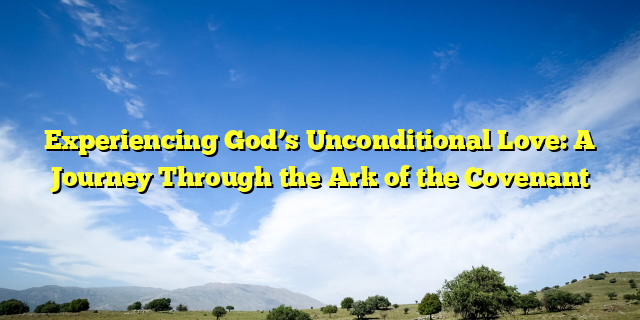Understanding Christian love, particularly Agape love and God’s unconditional love, can be transformative. This exploration delves into these profound concepts through the symbolism of the Ark of the Covenant, revealing how its design and purpose illuminate God’s unwavering love for humanity.
The Ark: A Symbol of God’s Presence and Protection
The Ark of the Covenant, more than just a historical artifact, embodies God’s presence among His people. Constructed of acacia wood overlaid with gold, it symbolizes Jesus’ dual nature: 100% man (wood) and 100% God (gold). This powerful image reminds us of Christ’s ability to empathize with our human struggles while possessing the divine power to overcome them.
Just as the Ark housed the Ten Commandments, Jesus, as the ultimate Ark, carries the weight of the law. He fulfilled the law perfectly, offering us freedom from its condemnation through His grace.
The Mercy Seat: Where Love and Justice Meet
The Ark’s lid, the Mercy Seat, is central to understanding God’s love. Once a year, blood was sprinkled on the Mercy Seat, covering the sins of the people. This act foreshadowed Jesus, the ultimate sacrifice, whose blood cleanses us from all unrighteousness.
The Mercy Seat demonstrates the beautiful intersection of God’s love and justice. While just in punishing sin, He poured out His love by providing a substitute, His Son, to bear the penalty in our place.
Contents of the Ark: Tokens of Rebellion Covered by Grace
Inside the Ark were three items: the Ten Commandments, Aaron’s rod that budded, and a golden pot of manna. These represent humanity’s rebellion against God’s standards, leadership, and provision. Yet, these tokens of rebellion were placed under the Mercy Seat, signifying God’s grace covering our failures.
This emphasizes the power of the finished work of Christ. God chooses not to see our imperfections because they are covered by the blood of Jesus. This truth allows us to approach Him with confidence, knowing we are accepted and loved despite our flaws.
The Journey of the Ark: God Going Before Us
The way the Israelites carried and followed the Ark provides further insight into God’s love. The priests carried the Ark using poles, symbolizing how God empowers us to carry out His will. When facing challenges, the Ark would go before the people, clearing the way and providing a resting place.
This illustrates God’s proactive love. He goes before us, preparing the path and protecting us from unseen dangers. He is both our leader and our rear guard, shielding us from attacks from behind. Just as the Ark went before the Israelites into the Jordan River, Jesus went before us into death, conquering it so that we might walk on dry ground.
Hearing His Voice: The Key to Following
Just as sheep follow their shepherd because they know his voice, we follow Jesus by discerning and obeying His voice. This doesn’t require complex formulas but a simple trust in the inner witness of the Holy Spirit. When we cultivate this sensitivity, we experience the fullness of God’s love and guidance in every area of our lives.
Experiencing Agape Love
Agape love, the selfless, unconditional love of God, transcends human understanding. It is demonstrated most powerfully in the sacrifice of Jesus, who laid down His life for us while we were still sinners. Embracing this love empowers us to love others unconditionally, extending forgiveness, compassion, and grace.
Conclusion: Living in the Light of His Love
The Ark of the Covenant serves as a powerful reminder of God’s unwavering love and provision. By understanding its symbolism, we gain a deeper appreciation for the depth of Agape love and the transformative power of God’s grace. As we focus on Jesus, the true Ark, we can live confidently, knowing we are eternally loved, protected, and guided by the Good Shepherd.
